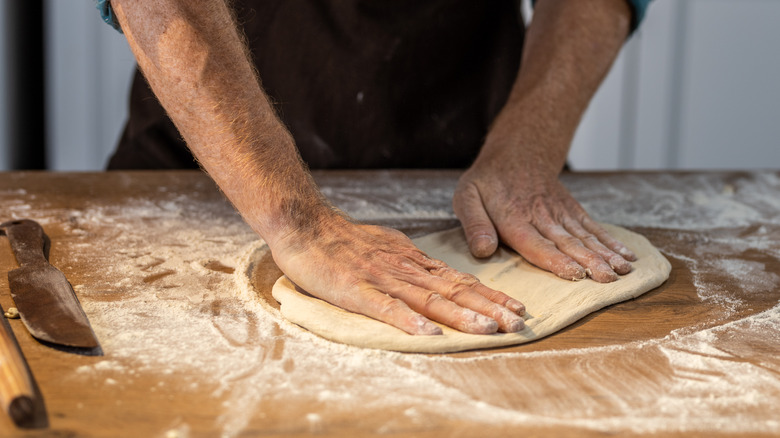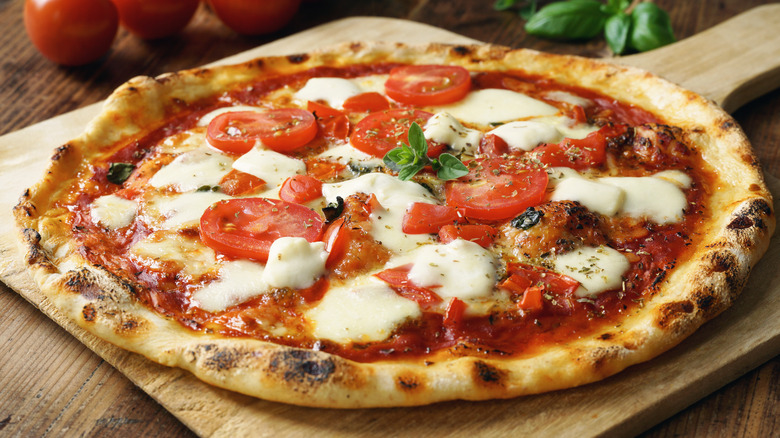Semolina Flour Is The Key To Ultra Crispy Homemade Pizza
There's truly nothing like an oven-hot, freshly baked pizza, whether it came from an artisan pizza maker or from your own kitchen. The crust, of course, is what makes it or breaks it — you want it to be that perfect balance of fluffy and crispy, soft and steamy inside with a nice bit of char on the outside. If your homemade pizza doesn't quite meet the mark when it comes to crispiness, however, there is one ingredient you ought to try: semolina.
Semolina is made from durum wheat, the same kind of wheat most often used for dried pasta, but ground less finely. If you dust your pizza dough with semolina instead of regular flour, that grittier texture will keep the pie from sticking to the baking surface and help it crisp up.
Durum wheat is known for its firm texture compared to other varieties of wheat, thanks to the dense amount of protein it contains and the formidable amount of gluten that develops as the dough is kneaded or rested. Dusting your pizza with regular, finely-ground wheat flour, though, can cause the dough to stick to surfaces if you use too little. If you use too much, you run the risk that each bite of crust will feel like getting blasted with a mouthful of dry, uncooked flour. The more roughly-ground semolina, however, eliminates this problem — adding flavor and crunch while keeping the dough from sticking.
Semolina is the crux of crunchy crust
There's one major difference between making a pizza at home or in a professional pizza kitchen: the oven. Unless you're fortunate enough to have a brick, wood-fired oven in your backyard, you're probably baking with a regular home oven that isn't made to get nearly as hot. A regular domestic oven typically has a maximum setting of 500 degrees Fahrenheit or thereabouts. A pizza oven, however, usually operates in the ballpark of 700 to 800 degrees Fahrenheit, sometimes up to 1000 degrees Fahrenheit.
When you're baking pizza at higher temperatures, it's easier to get some crispy char on the outside without overcooking the inside. Since your home oven can't get nearly as hot, it can be more challenging to achieve color and crunch on the dough without overshooting it and ending up with a mouth-splintering, unpleasantly hard crust — or worse, a pizza hopelessly stuck to the pan. Enter semolina flour.
Semolina is hearty — because of the bigger, harder granules, it doesn't absorb water as quickly as a normal powdery flour would. Since semolina is more durable than regular flour, the granules maintain their structure rather than just dissolving into the dough. This gives you a less sticky exterior, so your pizza can more easily slide off your chosen baking tools.
Swear off sad, soggy slices of pizza
Once you've perfected your use of flour, the last thing you want is to rain on your own pizza party by adding too much moisture and ruining any crispiness. For this reason, be intentional about what sort of pizza toppings you add.
Margherita pizza, for instance, calls for fresh mozzarella. But mozzarella is moist, and that liquid can end up seeping into the dough and keeping it from crisping up. To avoid this, first dry out the wet cheese by pressing it between your hands, then slice it and press the slices between paper towels. Another good practice is to use smaller chunks or thinner slices of mozzarella, so less water can hide in the middle.
Even your sauce can, in fact, be too moist and risk sogging up your pizza. You want your sauce to be on the thicker side, otherwise you risk drenching the dough with water and cooking off much of the tomatoey goodness. If you're using a pre-cooked tomato sauce that seems a little watery, cook it down on the stovetop to let some of the moisture evaporate. If you're starting with uncooked, canned tomatoes, blend them and then filter the purée through a fine strainer.
The best homemade pizza is a food that seems simple, but when made skillfully, can be transcendentally delicious. And if it takes you a few tries to get a super crispy, semolina-kissed crust, you know what they say — bad pizza is still pizza.


